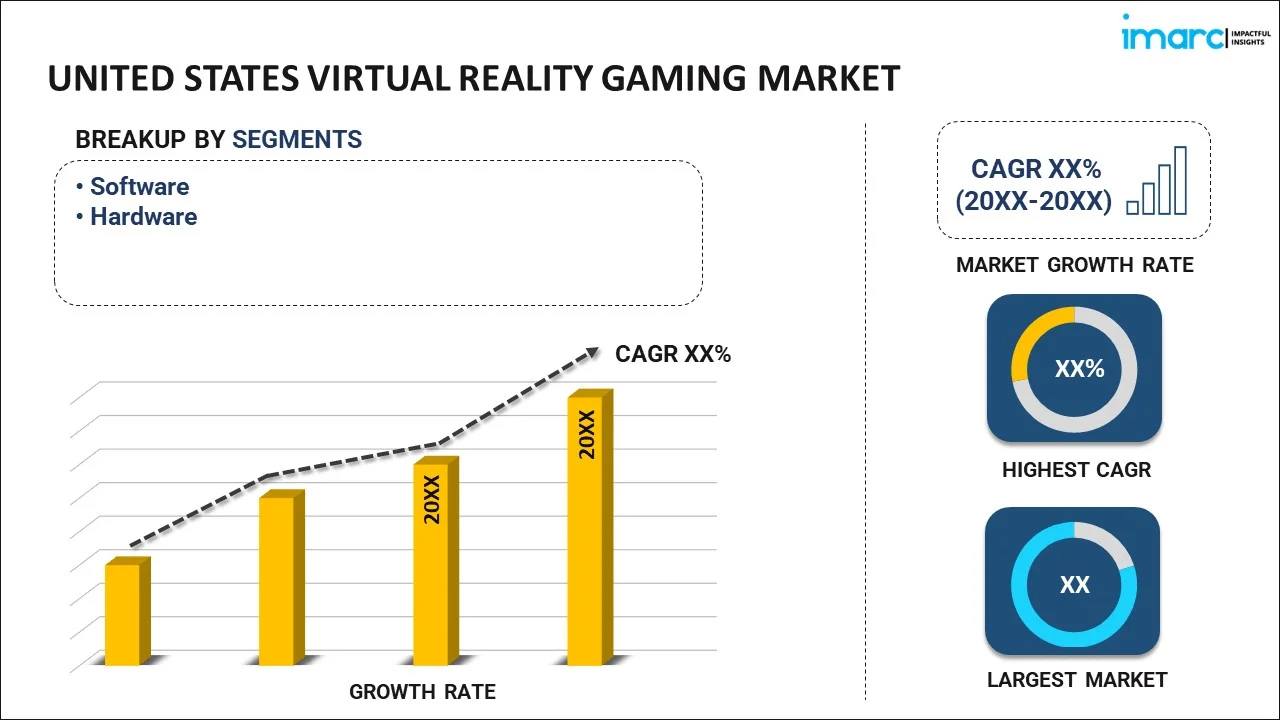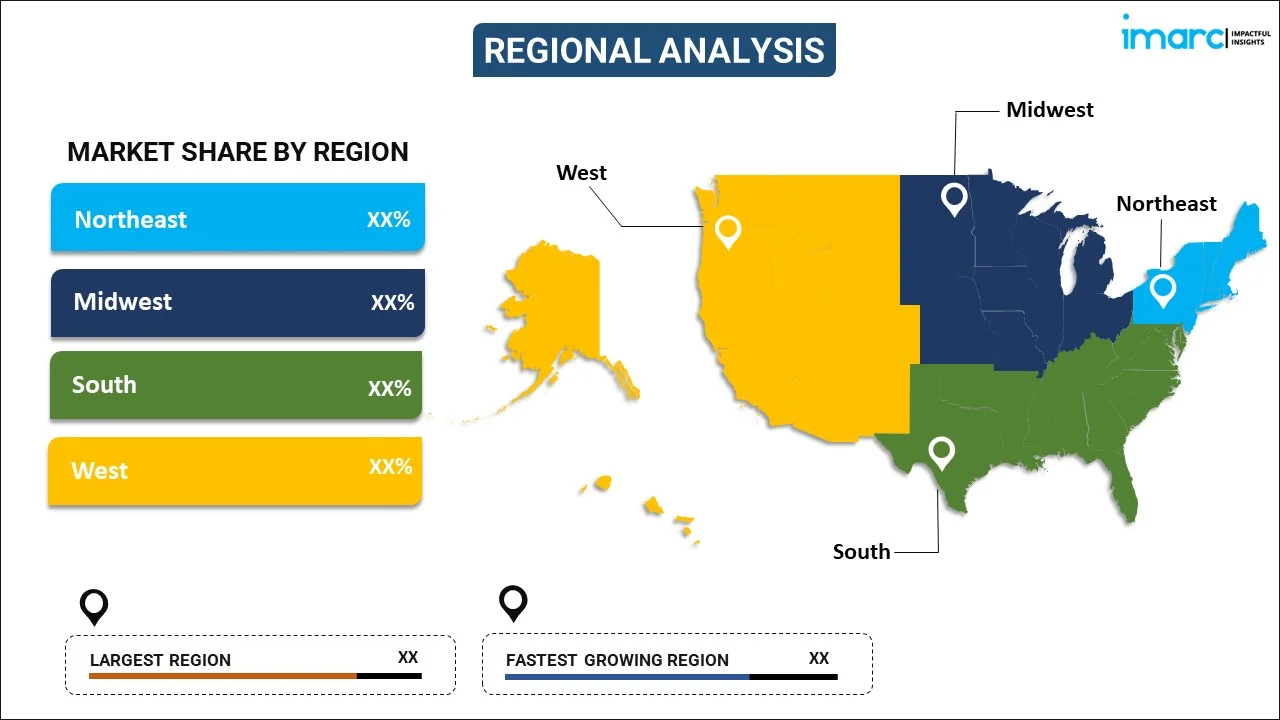
United States Virtual Reality Gaming Market Report by Segment (Software, Hardware), Device (Personal Computers, Gaming Consoles, Mobile Devices), Age Group (Adults, Children), Types of Games (Racing, Adventure, Fighting, Shooting, Mystery Thriller, Puzzle, Science Fiction, and Others), and Region 2025-2033
Market Overview:
The United States virtual reality gaming market size reached USD 12.9 Billion in 2024. Looking forward, IMARC Group expects the market to reach USD 68.6 Billion by 2033, exhibiting a growth rate (CAGR) of 20.4% during 2025-2033.
|
Report Attribute
|
Key Statistics
|
|---|---|
|
Base Year
|
2024
|
|
Forecast Years
|
2025-2033
|
|
Historical Years
|
2019-2024
|
|
Market Size in 2024
|
USD 12.9 Billion |
|
Market Forecast in 2033
|
USD 68.6 Billion |
| Market Growth Rate (2025-2033) | 20.4% |
Virtual reality (VR) gaming provides an immersive three-dimensional (3D) environment to users. These games are generally played on standalone systems, specialized game consoles and advanced laptops and personal computers (PCs). They rely on headsets, sensor-equipped gloves and hand controllers to offer realistic images, sounds and other sensations that simulate a user's physical presence in an imaginary world.
The escalating demand for interactive and realistic gaming experience among young people represents one of the major factors spurring the VR gaming market growth in the United States. Apart from this, the easy availability of high-tech VR headsets from brands, such as HTC and Oculus, is also bolstering the market growth. Furthermore, the launch of 5G technology is creating lucrative opportunities for market players to improve cloud gaming and offer more exciting and realistic gaming experiences to users. This, along with advancements in motion-capture technology and the introduction of haptic bodysuits, is anticipated to promote VR gaming adoption in the coming years.
Key Market Segmentation:
IMARC Group provides an analysis of the key trends in each sub-segment of the United States virtual reality gaming market report, along with forecasts at the country level from 2025-2033. Our report has categorized the market based on segment, device, age group, and types of games.
Breakup by Segment:

- Software
- Hardware
Breakup by Device:
- Personal Computers
- Gaming Consoles
- Mobile Devices
Breakup by Age Group:
- Adults
- Children
Breakup by Types of Games:
- Racing
- Adventure
- Fighting
- Shooting
- Mystery Thriller
- Puzzle
- Science Fiction
- Others
Breakup by Region:

- Northeast
- Midwest
- South
- West
Competitive Landscape:
The competitive landscape of the industry has also been examined along with the profiles of the key players.
Report Coverage:
| Report Features | Details |
|---|---|
| Base Year of the Analysis | 2024 |
| Historical Period | 2019-2024 |
| Forecast Period | 2025-2033 |
| Units | Billion USD |
| Segment Coverage | Segment, Device, Age Group, Types of Games, Region |
| Regions Covered | Northeast, Midwest, South, West |
| Customization Scope | 10% Free Customization |
| Post-Sale Analyst Support | 10-12 Weeks |
| Delivery Format | PDF and Excel through Email (We can also provide the editable version of the report in PPT/Word format on special request) |
Key Questions Answered in This Report
The United States virtual reality gaming market was valued at USD 12.9 Billion in 2024.
We expect the United States virtual reality gaming market to exhibit a CAGR of 20.4% during 2025-2033.
The increasing popularity of location-based entertainment, along with the escalating adoption of advanced laptops and PCs that provide detailed virtual environment and various gaming options, is primarily driving the United States virtual reality gaming market.
The sudden outbreak of the COVID-19 pandemic has led to the rising demand for virtual reality gaming systems by individuals as a means of indoor entertainment, during the lockdown scenario across the nation.
Based on the segment, the United States virtual reality gaming market has been segmented into software and hardware. Currently, hardware accounts for the majority of the total market share.
Based on the device, the United States virtual reality gaming market can be divided into personal computers, gaming consoles, and mobile devices. Among these, mobile devices currently exhibit a clear dominance in the market.
Based on the age group, the United States virtual reality gaming market has been categorized into adults and children. Currently, adults hold the largest market share.
Based on the types of games, the United States virtual reality gaming market can be segregated into racing, adventure, fighting, shooting, mystery thriller, puzzle, science fiction, and others. Among these, shooting game exhibits a clear dominance in the market.
On a regional level, the market has been classified into Northeast, Midwest, South, and West, where Northeast currently dominates the United States virtual reality gaming market.
Need more help?
- Speak to our experienced analysts for insights on the current market scenarios.
- Include additional segments and countries to customize the report as per your requirement.
- Gain an unparalleled competitive advantage in your domain by understanding how to utilize the report and positively impacting your operations and revenue.
- For further assistance, please connect with our analysts.
 Inquire Before Buying
Inquire Before Buying
 Speak to an Analyst
Speak to an Analyst
 Request Brochure
Request Brochure
 Request Customization
Request Customization




.webp)




.webp)












